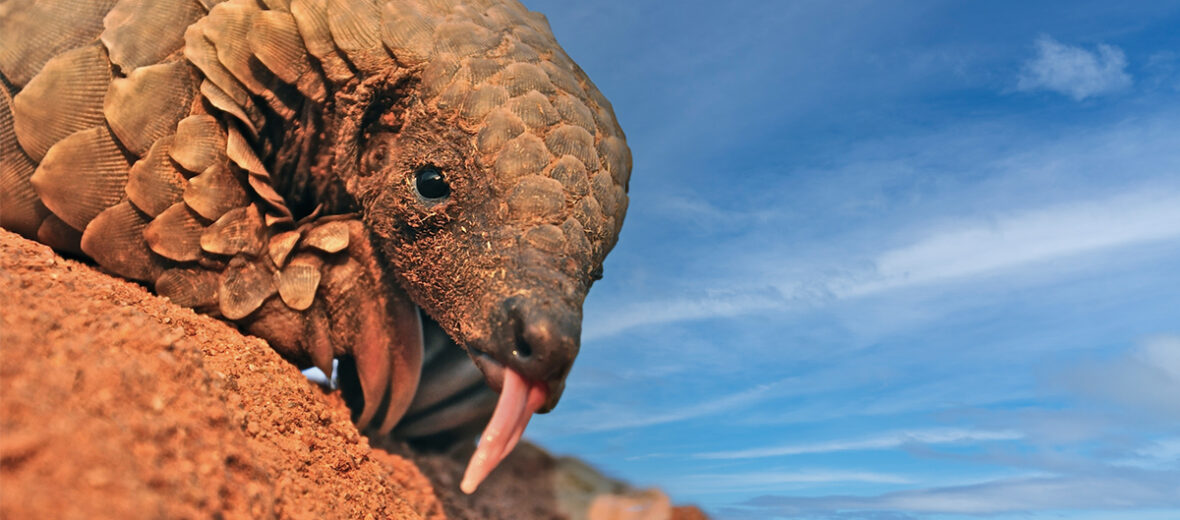
The ground pangolin, aka cape pangolin, common pangolin, scaly anteater, South African pangolin, steppe pangolin, or Temminck’s pangolin, hails from eastern and southern Africa. They prefer savannas and woodland habitats, close to water. Unfortunately, these critters face the threats of habitat destruction and loss at the hands of farming, ranching, logging, mining, and quarrying; habitat division at the hands of roads and railroads, which can also result in vehicle strike – being hit by vehicles; hunting; trapping; and habitat altering climate change. The IUCN lists these amazing creatures as Vulnerable, and their numbers are decreasing.
First the Stats…
Scientific name: Smutsia temminckii
Weight: Up to 39.6 lbs.
Length: Up to 23.6 inches, plus up to a 20 inch tail
Lifespan: Up to 20 years
Now on to the Facts!
1.) Their scales make up to 20% of their body weight.
2.) These unusual critters are among the most highly and illegally trafficked mammals in the world.
3.) The ground pangolin is the 2nd largest pangolin species, after the giant pangolin.
4.) They have 5 toes on each foot. Their forelimbs possess 3 long and sharp claws that are meant for digging out ant and termite mounds.
5.) These beasts have poor sight and hearing, but an excellent sense of smell.
But wait, there’s more on the ground pangolin!
6.) Ground pangolins are nocturnal (active at night).
7.) These creatures are solitary and only come together to breed.
Did you know…?
The tongue of a ground pangolin is actually longer than their body!
8.) Despite their namesake, these critters can climb and even swim very well.
9.) They are semi-fossorial (spend part of their time in burrows that they either construct themselves or that they utilize from other animals that have abandoned them. Recycled burrows utilized are often from anteaters and/or springhares.
10.) Their diet consists of ants, termites, larvae, and various soft-bodied insects.
But wait, there’s still more on the ground pangolin!
11.) These critters are polygynous (1 male mates with multiple females).
12.) Males fight rather aggressively with each other for breeding rights.
Did you know…?
When foraging, they will frequently walk on their hind legs.
13.) Females undergo up to a 139 day gestation that yields a single pangopup.
14.) The pangopup is brought out of the burrow once it reaches up to 4 weeks of age.
15.) A pangopup will often stay with its mother, and sometimes (although very rare) even its father for an additional 3 months, where it will then be weaned and become independent.
But wait, there’s still a tad more on the ground pangolin!
16.) A single pangolin can consume upwards of 70,000,000 insects a year!
17.) Small stones, called gastroliths, are ingested to aid in digesting the chitinous (hard exoskeleton) insects.
Did you know…?
The scales of a pangolin are made up of keratin, which is the same substance as human hair and fingernails. So, killing a pangolin for its scales for use in traditional medicine is the same as using human hair as medicine. It is useless and serves no purpose, nor does it harbor any medicinal value.
18.) Their common name hails from the Malay word “pengguling”, which translates to “rolling up”.
19.) The alternate common name Temminck’s pangolin, is in honor of the Dutch zoologist Coenraad Jacob Temminck.
20.) Primary natural predators include leopards, lions, pythons, owls, eagles, and chimpanzees. However, humans are their largest threat, by far.
Now a Short Ground Pangolin Video!
This video talks about pangolins in general.
Be sure to share & comment below! Also, check out the Critter Science YouTube channel. Videos added regularly!
Want to suggest a critter for me to write about? Let me know here.
Some source material acquired from: Wikipedia & IUCN
Photo credit: Palm Oil Detectives



